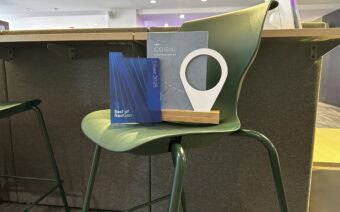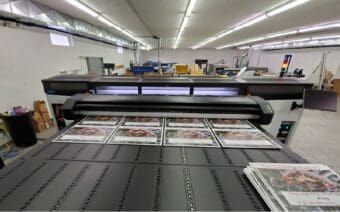July 1, 2024
GREEN BAY – The third annual Wisconsin Manufacturing Report – published by the Wisconsin Center for Manufacturing & Productivity – is informed by insights from 415 manufacturing executives from across the state.
In the survey, those executives ranked two industry concerns above all others:
- Keeping qualified employees
- Finding and attracting qualified employees
These concerns were identified as a greater concern than inflation, the economy and technology combined.
As the owner and CEO of Imaginasium – a Green Bay marketing agency primarily focused on the manufacturing industry – Jen Fietz said based on her consistent research and interviews with clients, these workforce concerns are valid.
As a former member of that workforce herself and the daughter of two factory workers, Fietz said she brings personal passion to bolstering one of Wisconsin’s most significant employment sectors.
“I would say 50-75% of my extended family has held some kind of manufacturing job,” she said. “I have a soft spot in my heart for manufacturing.”
Imaginasium’s efforts to help manufacturers address workforce woes, Fietz said, include extensive interviews with executives and with employees from all roles and crews.
“We’re doing a lot of heavy lifts right now on employer branding,” she said. “We’re going into manufacturing facilities (with) leadership away from the tables and sitting on night shifts around a table talking to the teams to say, ‘hey, what do you like about it here? What do you wish was different?’ We’re collecting that information to help them make improvements and to help us convey, ‘who is this company?’ ‘What do they stand for?’ And, ‘what kind of company is this?’ We want these people to be happy and continue working here.”
Fietz said these insights can aid employers’ retention rates and create a favorable, employer-of-choice culture to attract workers seeking manufacturing employment.
She said several factors are contributing to a diminishing pool of willing applicants statewide.
“(Wisconsin) doesn’t have the population to meet the demand of our manufacturers in the roles they have open,” she said. “And, our education is not matching what those manufacturers need to upskill and have the people they need – so there’s a little bit of a disconnect they’re working hard to try and connect.”
Fietz said another area of misalignment is the outdated and unfairly placed perception of working in manufacturing – which highly contradicts its bright, clean and increasingly high-tech reality.
“I grew up in the ’80s and ’90s, so I saw manufacturing for what the stigma still is today – these are dark and dingy, low-paying jobs with brutal schedules, and people who don’t have an education fit the roles there,” she said. “That’s not the case anymore. We have to change the image of manufacturing.”
Retention
In 2019, Fietz said, Imaginasium began focusing deeper on the manufacturing industry.
With the impact of the COVID-19 pandemic in 2020, she said the agency helped manufacturing clients to adjust workers’ salaries amid the economic changes.
That type of rightsizing is always of utmost importance, Fietz said, but in what she describes as “an employee’s market,” employers must go beyond wages in an industry competing for workers.
“I find more companies trying to find creative ways to share in earnings,” she said. “Our job is to figure out how to grow our businesses and generate revenue. How they give back to all types of employees – whether they’re sitting next to you at the C-suite table or running something in your manufacturing facility – some type of earnings payout is important to them. They feel a part of the celebration of achieving a goal.”
Another such option she’s seeing, Fietz said, is manufacturing companies choosing to establish an ESOP, or employee stock ownership program.
Another top issue most commonly cited as frustrating by manufacturing employees, Fietz said, is scheduling.
She said she recalls firsthand the strict shifts she had to abide by working at a factory.
“Now, these companies are competing on (job) flexibility,” she said. “Shifting models were rigid, and for the manufacturers I have been engaged with, they’ve gotten good at creating independent environments. ‘Hey, I know we’re working these shifts together – can you come in and work three hours for me so I can go to Jimmy’s game – and then I’ll work here Saturday morning?’ They’re allowing for more independence and shift control with the people who are on those specific crews.”
The second most common issue to emerge from staff interviews, Fietz said, is communication – or lack thereof.
“We forget that John, who runs the press, doesn’t have corporate email, so he’s not checking his email every day – his job is to watch and ensure the machine runs successfully,” she said. “I’m a Gen X. We got updates at our quarterly company meetings, and that was fine with us. That’s not okay for Millennials and Gen Zs. They’re used to getting updates on everything – so how are we staying connected with our workforces?”
Fietz said companies are increasingly utilizing smartphones for punching in and out of shifts, providing paycheck deposit notifications and as a tool for sharing news with employees about the company or its upcoming events.
“To take it a step further, some of the big companies are moving toward a headset you can connect your phone,” she said. “Everyone likes to listen to music, but most (employees) can’t, and they can’t have their phones (while working). You can connect (the headset) to your platform and then put your phone away – so now you’re listening to your music on your channel, but it can be interrupted. From a safety perspective, it’s interrupted if something (urgent) is happening. And it’s interrupted for ‘commercials’ – and those commercials are updates from the company like, ‘hey, don’t forget our company picnic is this Saturday – bring your kids.’”
Company-sponsored events, Fietz said, represent another type of culture-minded retention effort, as well as other common options, including free snack days or company merchandise.
She said she understands the struggles of manufacturing companies looking to effectively reward employees’ hard work and loyalty in new ways.
“People value lots of different things,” she said. “That individual who wants eight hours to go and volunteer is stacked up against the person who would find value in you paying for a Hulu or a Netflix subscription or pet insurance. I think that’s why HR teams are spread so thin across many sectors of business. They’re constantly trying to come up with the right suite of what maps us back to making sure our employees stay.”
The greatest inspiration, Fietz said, always comes directly from team members and investing in resources that surpass training expenses.
“They’re doing a much better job of going to their workforce and listening,” she said.
Recruitment
Attracting new applicants to manufacturers, Fietz said, relies in part upon broadcasting the benefits companies offer as part of retention incentives.
But the full branding, she said, should also showcase the relationships and collaboration employees experience.
“People are looking for camaraderie,” she said. “They want to know the people they’re going to work with are hardworking and fun, and that’s the common thread I’ve heard through all of (our interviews) from 2019 to now.”
Fietz said highlighting individual team members is one method by which a company can better represent what it’s like to work there.
“We want to hear it from your employees, not from (executives) because you might just be telling me what I want to hear,” she said. “In those cool storytelling moments, we can say, ‘this is Brent – Brent just finished his welding degree’ – and he talks about how his company is employee-owned and what that means to him and his wife, how he believes he is well paid and the company cares about him and the community.”
Testimonies regarding community involvement and philanthropy, Fietz said, can also signal to younger candidates in particular a given company’s values.
“Gen Z and Millennials care a ton about how a company is giving back – because it’s how they were raised,” she said. “They want to work for a company that takes care of its own – and takes care of the community it’s in.”
Reimagining
Fietz said her and the Imaginasium team’s efforts to update the image of its clients will ideally extend to a more positive portrayal of the industry as a whole.
“When we look at manufacturing, there is a PR campaign that needs to happen so we get the news out – ‘gone are my grandfather’s factories,’” she said. “It’s important for us to take a fresh look at what manufacturing looks like.”
She said contemporary factories are much safer and more comfortable than those of past generations – “but the machinery and work itself have advanced to nearly unrecognizable degrees.”
“Today’s plants often look more like high-tech companies than factories,” she said. “There’s an opportunity to open the door to the young people coming out of high school and college and the parents (as well). We’ve got to start explaining what career paths exist inside of these manufacturing facilities. They’re the best-kept secret.”
Fortunately, Fietz said, the opportunity to spread awareness of these careers coincides with greater advancements in automation and artificial intelligence as Industry 4.0 arrives.
“We’ve got to flip so we’re attracting the next generation,” she said. “There’s something cool we’re on the cusp of.”
According to New North, Inc., manufacturing represents 25% of all gross domestic product (GDP) of Northeast Wisconsin – making it a top priority for Wisconsin business growth.
New North has a 2.8 times greater manufacturing concentration than the national average.
Of the 9,041 manufacturing companies (supporting 480,685 jobs and an output of $75 billion) in the state, 2,135 (supporting 140,537 jobs and an output of $20.7 billion) are located in the New North.
Fietz said a campaign to improve the industry’s passé reputation would likely require a coalition of state or even federal funds, manufacturers and multiple PR and strategy firms.
In the meantime, Fietz said she recommends folks research companies, tour their facilities or – especially for young people lacking clarity on their career paths – experience the industry first-hand as she once did, even if only for a summer.
“I don’t think you’ll regret it,” she said. “There’s a lot of pride inside these manufacturing facilities. The people you meet and the work it supports across the world – there’s a lot of great things.”
Fietz said she’s seeing encouraging collaboration among manufacturers’ HR, marketing and sales departments as they recognize how job vacancies hurt their entire company.
Beyond the lack of production itself, she said her research suggests potential customers may decide to do business with a company based on inferences from how many positions they have open.
“I think they’re trying to see – ‘is this a company that has a lot of turnover?’” she said. “‘How do they treat their employees? Are they going to do the work I’m considering giving them?’”
Fietz said she believes the manufacturing leaders who best adopt this modern mindset will successfully attract new talent of all ages.
“We have an amazing group of leaders in these companies championing innovation and technology and still trying to take care of the loyal people who have gotten them to today,” she said. “There’s an opportunity for manufacturers to define career journeys. Gen Zs specifically want to know what their career journey is – and a good leader can facilitate you through that.”
 Bringing the convenience of the city to the middle of nowhere
Bringing the convenience of the city to the middle of nowhere At a Fond du Lac County orchard, market – a ‘Little’ goes a long way
At a Fond du Lac County orchard, market – a ‘Little’ goes a long way








